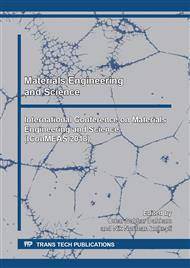[1]
N. Widiarti, J. Sae, and S. Wahyuni, Synthesis CuO-ZnO nanocomposite and its application as an antibacterial agent,, Mater. Sci. Eng., (2017).
DOI: 10.1088/1757-899x/172/1/012036
Google Scholar
[2]
Y. Chen, H. Ding, and S. Sun, Preparation and Characterization of ZnO Nanoparticles Supported on Amorphous SiO2,, nanomaterials, (2017).
DOI: 10.3390/nano7080217
Google Scholar
[3]
G. Salek, C. Tenailleau, P. Dufour, and S. Guillement-Fritsch, Room temperature inorganic polycondensation of oxide (Cu2O and ZnO) nanoparticles and thin films preparation by the dip-coating technique,, Thin Solid Films, vol. 589, p.872–876, (2015).
DOI: 10.1016/j.tsf.2015.04.082
Google Scholar
[4]
S.S. Sawant, A.D. Bhagwat, and C.M. Mahajan, Synthesis of Cuprous Oxide (Cu2O) Nanoparticles – a Review,, J. nano-and Electron. Phys., vol. 8, no. 1, p.1–5, (2016).
Google Scholar
[5]
V.Y. Yerokhov and I.I. Melnyk, Porous silicon in solar cell structures: a review of achievements and modern directions of further use,, Renew. Sustain. energy Rev., vol. 3, p.291–322, (1999).
DOI: 10.1016/s1364-0321(99)00005-2
Google Scholar
[6]
P. Menna, G. Francia, and V. Ferrara, Porous silicon in solar cells : A review and a description of its application as an A R coating,, Sol. energy Mater. Sol. cells, vol. 37, p.13–24, (1995).
DOI: 10.1016/0927-0248(94)00193-6
Google Scholar
[7]
Y. Chang, M. Zhang, L. Xia, J. Zhang, and G. Xing, The Toxic Effects and Mechanisms of CuO and ZnO Nanoparticles,, Materials (Basel)., p.2850–2871, (2012).
DOI: 10.3390/ma5122850
Google Scholar
[8]
C. Kuo, R. Wang, and J. Huang, The Synthesis and Electrical Characterization of Cu2O/Al:ZnO Radial p–N Junction Nanowire Arrays,, Nanotechnology, no. August, (2009).
Google Scholar
[9]
W. Phoohinkong, T. Foophow, and W. Pecharapa, Synthesis and characterization of copper zinc oxide nanoparticles obtained via metathesis process,, Adv. Nat. Sci. Nanosci. Nanotechnol., vol. 8, (2017).
DOI: 10.1088/2043-6254/aa7223
Google Scholar
[10]
P. Krishnamurthi, Y. Raju, Y. Khambhaty, and P. T. Manoharan, Zinc Oxide-Supported Copper Clusters with High Biocidal Efficacy for Escherichia coli and Bacillus cereus,, ACS OMEGA, vol. 2, (2017).
DOI: 10.1021/acsomega.7b00214
Google Scholar
[11]
X. Zou, H. Fan, and S. Yan, Synthesis of Cu2O/ZnO hetero-nanorod arrays with enhanced visible light-driven photocatalytic activity,, CrystEngComm, vol. 16, p.1149–1156, (2014).
DOI: 10.1039/c3ce42144a
Google Scholar
[12]
Happy et al., Effect of deposition parameters on morphology and size of FeCo nanoparticles synthesized by pulsed laser ablation deposition,, Appl. Surf. Sci., vol. 252, no. 8, p.2806–2816, (2006).
DOI: 10.1016/j.apsusc.2005.04.026
Google Scholar
[13]
C. V Niveditha, A. C. Nizamudeen, R. Ramanarayanan, M. J. J. Fatima, and S. Swaminathan, Showcasing electrode-electrolyte interfacial potential as a vital parameter in the hydrogen generation by metal oxides electrodes,, Mater. Res. Express, vol. 5, no. 3, p.35504, (2018).
DOI: 10.1088/2053-1591/aab076
Google Scholar
[14]
Y. Lu, H. Cao, C. Zhang, and X. Zhang, Shape controlled synthesis of superhydrophobic zinc coordination polymers particles and their calcination to superhydrophobic ZnO,, J. Mater. Chem., vol. 21, no. June, (2011).
DOI: 10.1039/c1jm10957j
Google Scholar
[15]
A. M. Mostafa, S. A. Yousef, W. H. Eisa, M. A. Ewaida, and E. A. Al-Ashkar, Synthesis of cadmium oxide nanoparticles by pulsed laser ablation in liquid environment,, Optik (Stuttg)., vol. 144, no. July, p.679–684, (2017).
DOI: 10.1016/j.ijleo.2017.06.065
Google Scholar
[16]
L. Filipponi and D. Sutherland, Nanotechnologies: Principles, Applications, Implications and Hands-on Activities. Luxembourg: Publications Office of the European Union, (2012).
Google Scholar
[17]
S. S. Shinde, R. A. Bansode, C. H. Bhosale, and K. Y. Rajpure, Physical properties of hematite α-Fe2O3 thin films: Application to photoelectrochemical solar cells,, J. Semicond., vol. 32, no. 1, p.1–8, (2011).
DOI: 10.1088/1674-4926/32/1/013001
Google Scholar


